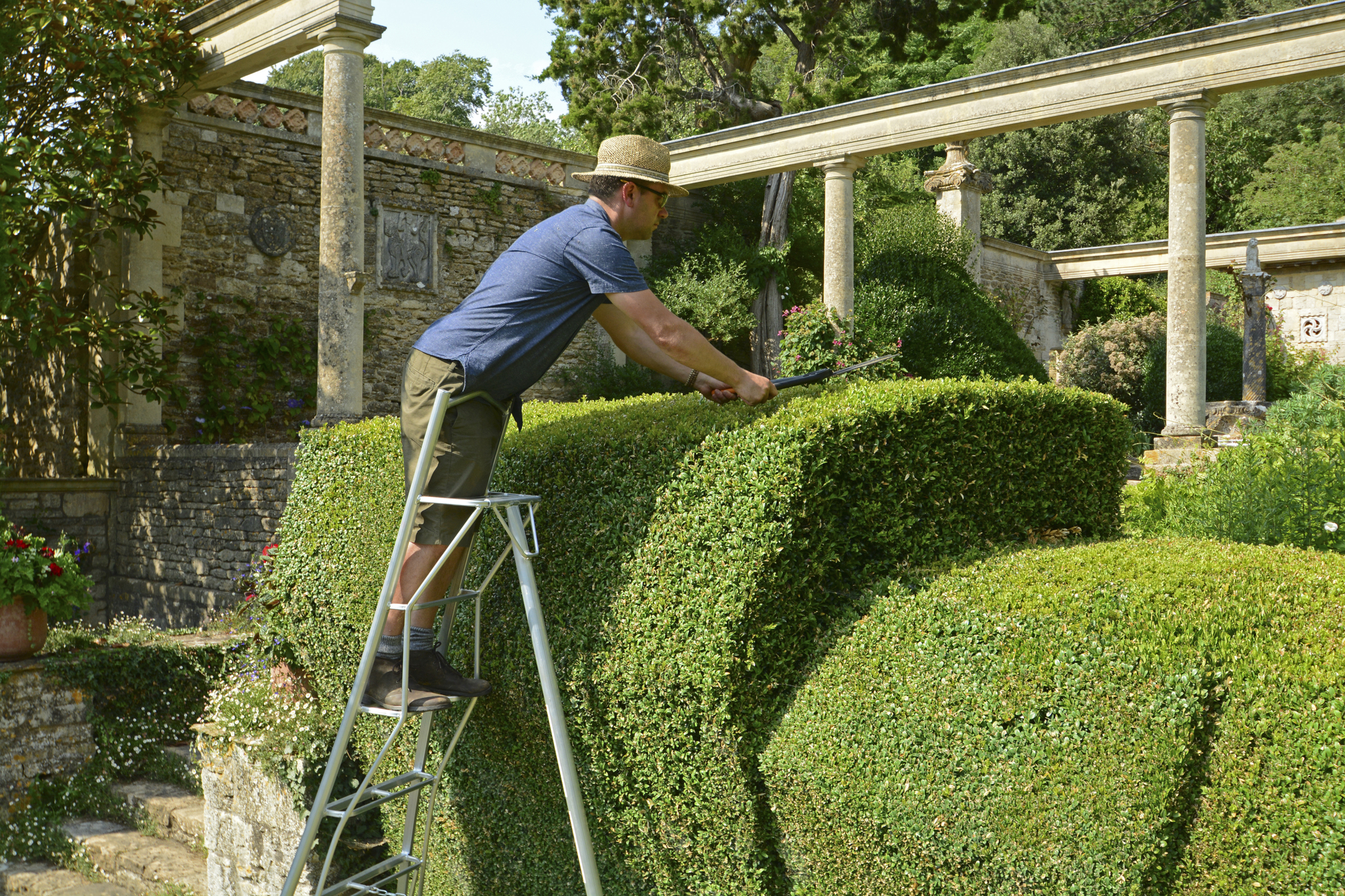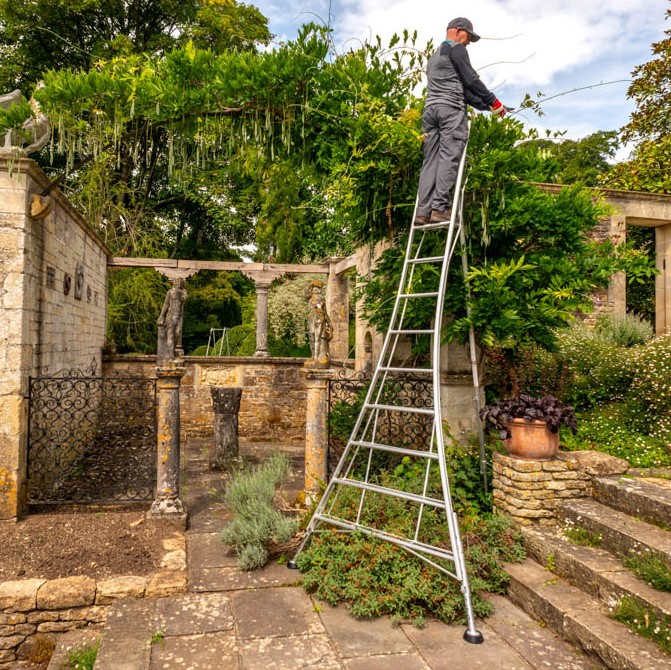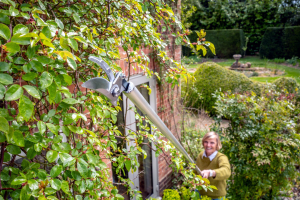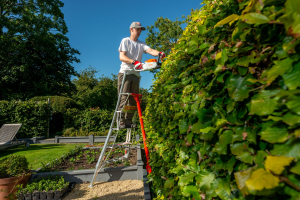A guide to hedge cutting safely

Hedges are commonly used to improve property aesthetics, increase privacy and even protect properties from the wind. They’re popular when compared with alternatives such as fences, because they stay green and vibrant all year round, offer sanctuary for wildlife, and when well looked after, can even increase the value of your home. Overall, hedges are a good thing!
But on the flip side, overgrown hedges can leave your property looking untidy and unkempt. And if left for too long without trimming, they can also be really difficult to get back under control, and can even damage your property. That’s why each year, hedge-owners need to tackle the challenge of hedge trimming.
If the prospect of hedge trimming feels overwhelming, don’t worry. We’re here to make it a bit easier, and more importantly, safer! This guide will explain everything you need to know about trimming hedges, and how to stay safe while you’re doing it.
Use the drop down links below to navigate this article:
When to trim your hedges
Before you start your hedge trimming, check that it’s an appropriate time to cut them. For example, when to trim your hedges will depend on several factors, including:
- how old your hedges are
- For example, do you need to maintain an established hedge, or form your newly planted hedge?
- how formal and neat you want your hedges to be
- the type of shrub that makes up your hedge
Trimming new hedges
If you have planted your hedges in the last year or two, they’ll need more regular trimming than established hedges. This is called formative pruning, and the most labour intensive element of this type of hedge trimming is best carried out in winter or early spring. We’ll talk more about formative hedge trimming later. You can skip to this part of the article here.
Trimming established hedges
If your hedges are older and more established, you’ll only need to trim your hedges once a year if it’s an informal hedge, or up to two or three times a year if it's a more formal, tidy looking hedge.
Maintenance trimming is generally carried out between spring and summer when hedges experience most growth. As previously mentioned, always be aware of nesting birds during this time and delay trimming if needed.
The RHS has a detailed guide about when to cut different types of shrubs, as some plants respond better to cutting at certain times of the year.
Hedge cutting tools that keep you safer
When you’re ready to start trimming your hedges, you’ll need some special equipment to do it safely and efficiently.
At Henchman, we specialise in products that make it safe for you to work at height - from the ladder you stand on, right the way to the gloves you use. Here’s a list of products that you’ll need in order to cut the hedges effectively:
Hedge cutting ladder
For almost all hedges, you’ll need a ladder to reach the higher branches. You’ll even need one for shorter hedges so you can trim the top branches safely without having to overreach while using heavy and specialist equipment. Basically, when it comes to hedge trimming - ladders are a must have piece of equipment! And you'll need a ladder designed for use in the garden. Conventional step ladders aren't safe to be used on uneven or soft ground.
Henchman ladders are especially designed for jobs like trimming hedges. Our selection of different hedge trimming ladders can be used by homeowners and professionals alike, with a range of sizes and styles to choose from.
Hedge cutting tripod ladders
Our hedge cutting tripod ladder range offers excellent safety, with the no-wobble tripod structure ensuring greater stability compared with traditional stepladders. They’re also light and easy to move around when working, enhancing your workflow and helping you get the job done quicker.
In addition, the built in working platform allows you to tuck your knees into the frame for extra stability, which also allows you to use both hands safely as you work. The extra stability also means you won’t need another person to foot the ladder.
They’re available from 6ft to 16ft, and you can choose between our three or one adjustable leg model.

The Hi Step ladder for hedge cutting
Henchman’s Hi Step ladder has four large, adjustable feet that offer a level, stable and non-slip foundation. This allows you to work hands free. As all 4 legs adjust independently up to 2ft, it can be used on hedges of multiple heights and can even be extended further with the Adjustable Platform Step Ladder Extender. Compared with the tripod ladder, they are slightly more versatile as they allow you to cut a wider stretch.
It’s also designed specifically to provide a spacious, level and comfortable working space that keeps you secure and safe when working at height.
They’re available from 6ft to 10ft with extenders available, too.
Hedge cutting platform
Ideal for professionals or homeowners with long stretches of hedge to trim, the wheeled Henchman is a hedge cutting platform that offers a stable and spacious working platform. It allows you to move safely in four directions, and it’s no toppling design helps you remain level and stable even if you’re working on soft, sloping or uneven terrain. Extendable with an extender, you can choose from a 4ft or 5ft model.
Hedge cutting trimmers
When it comes to hedge trimmers, there are lots of different types of hedge trimmers available from a variety of suppliers. The hedge trimmer you use will depend on your budget, size of your hedge and size of your garden. These are the three most common types of hedge trimmers:
-
Petrol hedge trimmers
-
This type of hedge trimmer is the most powerful available. It uses petrol to power the motor instead of electricity, making it especially useful if you need to cut hedges with large twigs and branches. It’s also cordless which makes it more flexible and safer to use.
-
Corded electric hedge Trimmers
-
These trimmers are ideal for smaller gardening tasks, as can only be used where there’s an electrical outlet available. You can extend the range of the electric hedge trimmer by connecting it to an extension cord, but these are not ideal for larger gardens or taller hedges. Be aware that corded electric trimmers aren’t safe for use with tall ladders.
-
Cordless electric hedge trimmers
-
Cordless trimmers are also electric hedge trimmers, but they use a rechargeable battery. They’re excellent for safer, flexible working, but they’re not quite as powerful as regular electric or petrol trimmers, Bear in mind that they need to be recharged every hour or so, which can limit workflow.
Hedge cutting gloves
To keep your hands safe, you’ll need a pair of heavy duty hedge cutting gloves. Our special Henchman gardening gloves are ideal for hedge trimming. Hard wearing leather covers the palm, fingertips and knuckle to protect against thorns and twigs, while the elasticated back and padded palm provide a snug and flexible fit.
Hedge cutting secateurs
To help with the pruning of your hedge, you’ll need some pruning secateurs. Our pruning secateurs are ideal for fine tuning your hedge trimming.
Hedge trimming techniques
Now you have the right equipment, you can get started with your hedge trimming project.
There are lots of different techniques for trimming hedges, but your style of hedge trimming will depend on the type of shrub that makes up your hedge and the stage your hedge is at. Again, the RHS has incredibly detailed guides on how to trim different types of shrubs depending on their composition and species.
We’ll outline the basics to hedge trimming below.
Cutting a hedge back - maintenance hedge trimming
This type of hedge trimming is required for hedges that are already established and it needs to be done about two to three times a year.
As you’ll already have a well formed hedge shape to start with, maintaining the hedge mainly involves clipping the hedge back so it tapers in size towards the top of the hedge. You’ll need to do this because hedges naturally grow into a V shape over time.
This happens because the top part of the hedge receives more sunlight than the bottom, meaning the top of the hedge grows and widens faster. In turn, this causes shade to prevent sunlight from reaching the bottom of the hedge resulting in the bottom producing less foliage and becoming narrower.
To counteract this, maintenance trimming requires you to:
- shear the hedge so that the base is wider than the top
- shear your hedge at such an angle that the top starts off narrower than the bottom of the hedge. This ensures the bottom foliage gets maximum sunlight and leads to a more even hedge over time.
- always start shearing from the bottom up
- as you move up the hedge, amend your cutting angle to create a narrower top. Always check between trims to check your work.
- avoid removing branches that make the skeleton of the tree.
- Only ever remove up to 25% of the external branches and don’t touch the thicker structural branches.
Formative hedge trimming
Formative hedge trimming is slightly more complicated than maintenance trimming and requires more planning too. A lot of this trimming needs to be done at certain times of the year, so you need to be ready!
Generally, you’ll need to do formative hedge trimming from plantation up until the hedge is about two or three years old, depending on when you plant it. This is important to ensure the hedge grows into the desired form. From then onwards, the hedge will only need to be maintained.
Step by step guide to formative hedge trimming
- Upon planting your hedge, cut the branches back to the desired height and shape. Don’t cut the top of the hedge.
- Trim the hedge after regularly, roughly leveling out the outside layers of your hedge while maintaining the base so it’s slightly larger than the top of the hedge. This will allow all the branches to benefit from the sun.
- For the first summer pruning, only trim the side branches lightly - this will encourage bushing out which will add to the volume of your hedge.
- In the second year, around late winter/early spring time, cut your hedges growth back by half.
- Throughout the hedge’s second summer, regularly trim the side branches to encourage growth that tape’s towards the top.
- In the second autumn you can finally cut the top of the top of the hedge, (also known as the ‘leading shoot’, to create the final desired hedge height.

Garden hedge cutting law
Before you get your hedge trimmers ready, there are some rules and guidelines you need to be aware of, from both an environmental and neighbourly point of view.
The Wildlife and Countryside Act 1981
This first rule relates to Section 1 of the Wildlife and Countryside Act 1981. This law states that it’s a criminal offence to intentionally damage or destroy a wild bird’s nest while it is being built or in use. Hedges are commonly used by nesting birds.
Many birds nest between March and August, so you need to be very careful if you trim your hedges during this time. It’s generally advisable to avoid cutting your hedges during the breeding season if possible. If it’s unavoidable, it’s a legal requirement for you to check for active nests prior to cutting, and if there are nesting birds in the hedge, you must wait until breeding season is over. The RSPB has more information on the topic.
Anti-Social Behaviour Act 2003
In the UK, if you’re the owner of a hedge that separates two property lines, you need to make sure that your hedge doesn’t encroach on your neighbours property, and doesn’t grow too high. Generally, hedges taller than two metres are in breach of the Anti-Social Behaviour Act 2003, so you’ll need to make sure your hedges are at a legal height, and cut them shorter if necessary. You can find out more about this legislation here.
Hedge cutting with Henchman
At Henchman, we’re all about keeping you safe when working at height. With hundreds of thousands of homeowners tackling hedge cutting each year, our goal is keep you as safe as possible.
That’s why we’ve created our range of hedge trimming products that are especially designed to keep you as safe and secure no matter what terrain you’re working on, and no matter how high your hedge is. Head to our products and discover our range of products designed to keep you safe when working at height.



